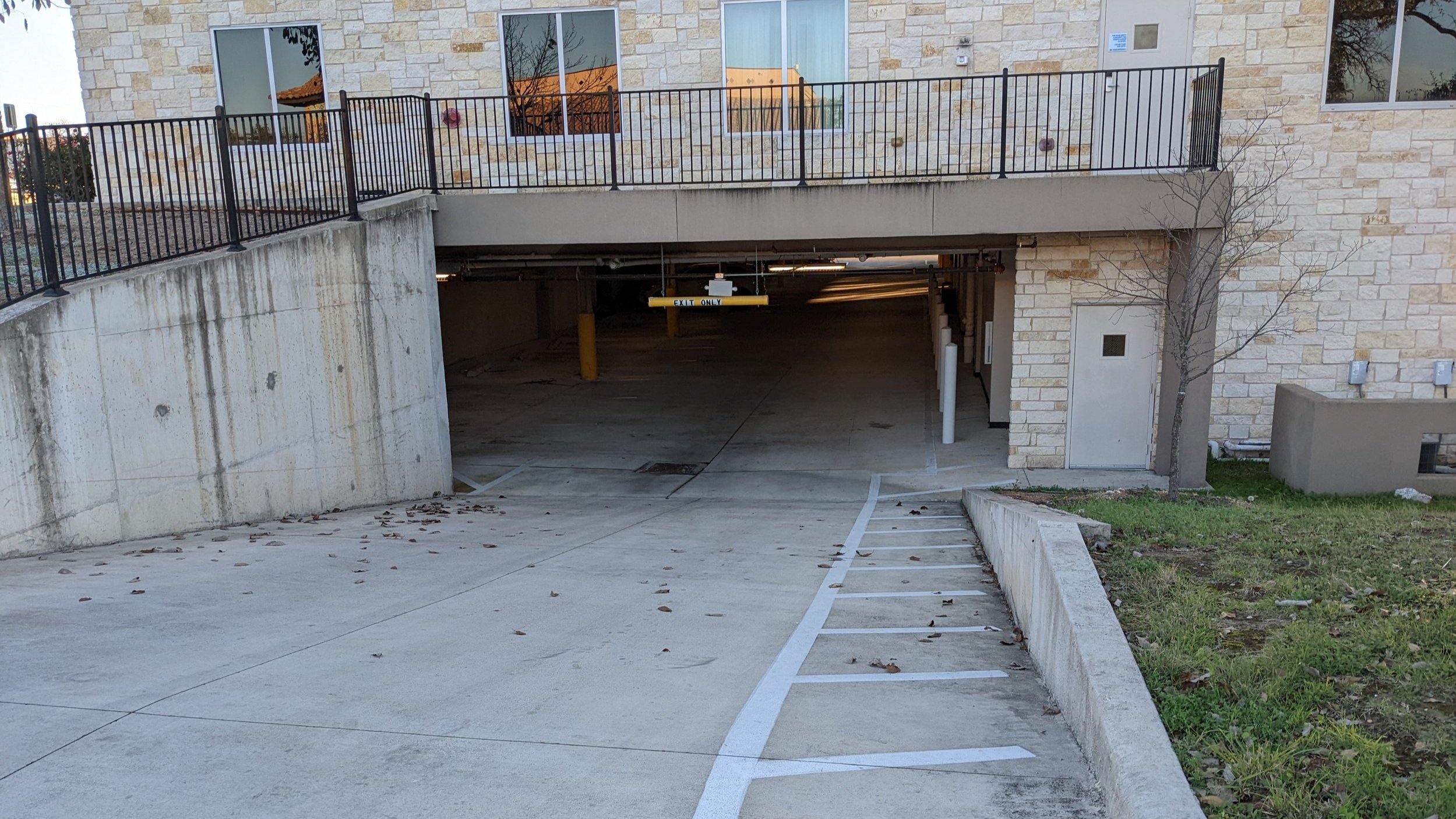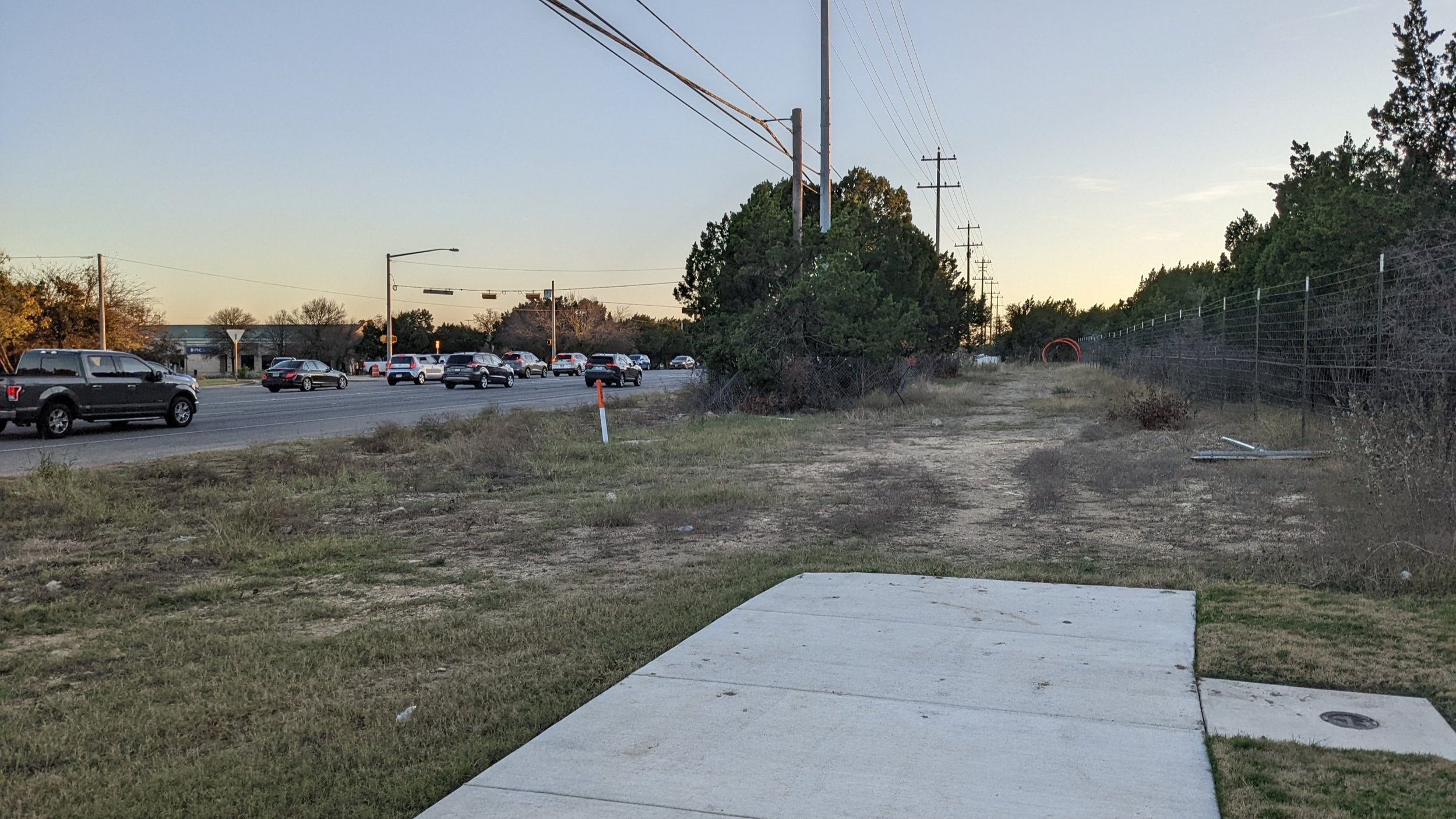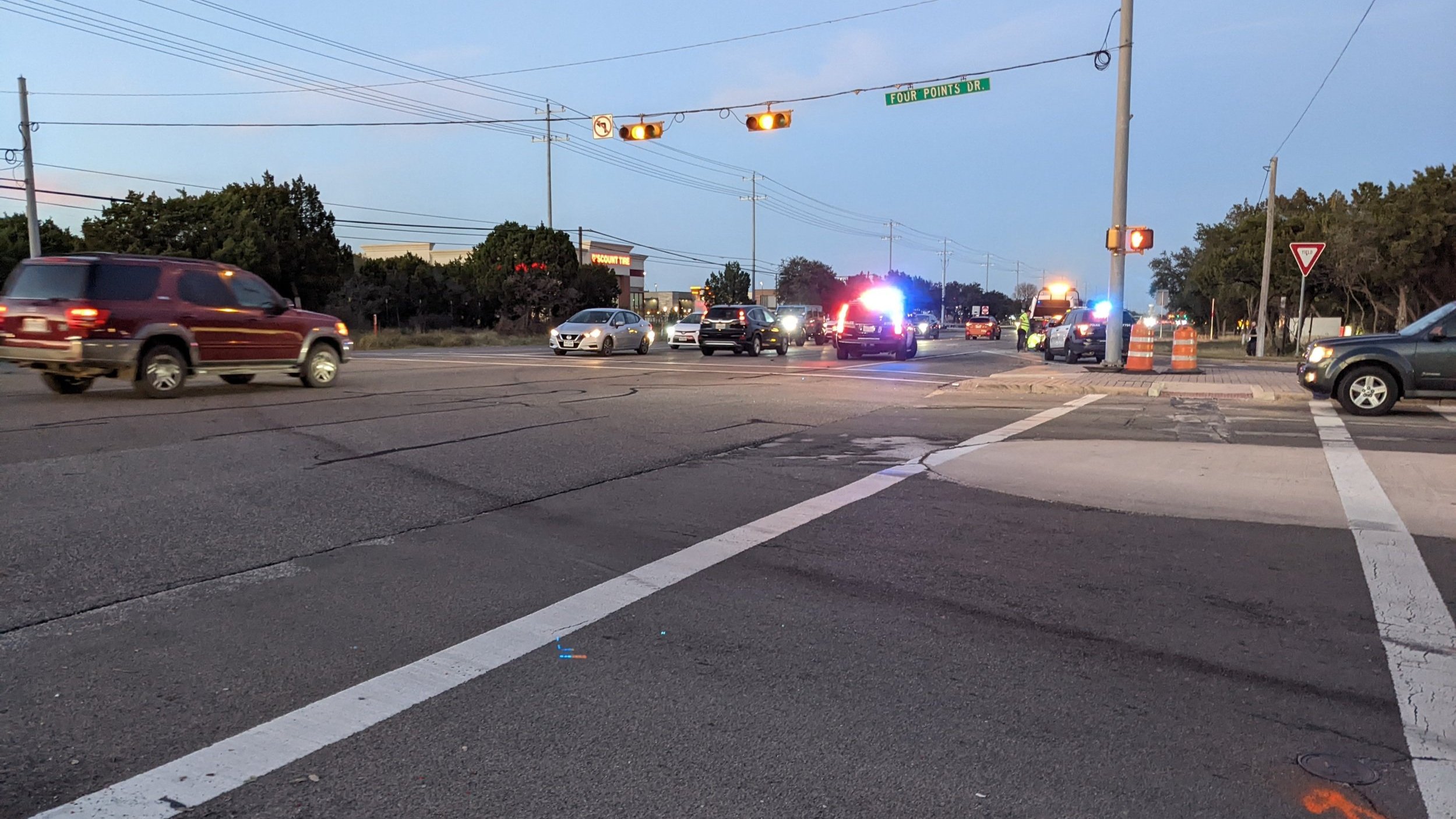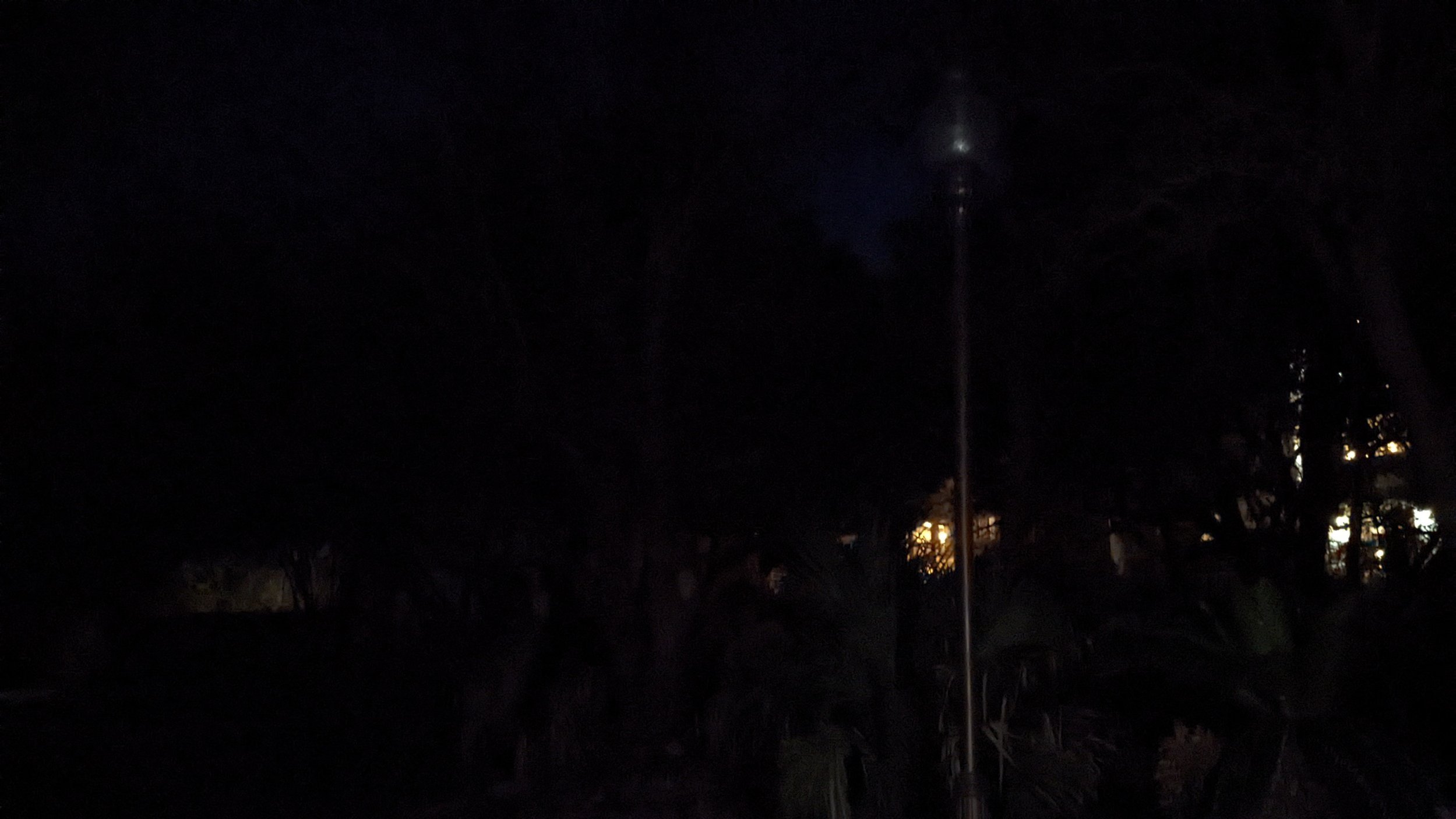American Suburbs Are a Horror Movie and We’re the Protagonists
My partner and I regularly have to pass this street next to an abandoned bank. There’s no sidewalk, yet cars zoom around the corner all the time. Creepy and dangerous!
This past year, my partner Dakota and I have been making an effort to walk to the nearest grocery store, rather than drive there. It’s a roughly four-mile round trip, and thus a little time consuming, but it’s very doable when it’s not a hundred degrees outside.* We both have desk jobs, so we enjoy the opportunity to get out, stretch our legs, and just chat without distraction.
(*A little aside here: We live in Austin, Texas, and for the duration of this article, I beg your forgiveness as I get loose with terminology. We live on the edge of Austin, so we are technically in a “city,” but our neighborhood is built much more like a suburb. Frankly, most of Austin, and Texas as a whole, is built like a suburb. So I am using the term “suburb” here as shorthand for the Suburban Development Pattern—and again, I beg your forgiveness as I do so.)
During Thanksgiving, Dakota went back to his hometown in east Texas and decided to stay with his family for a week, so I stayed behind to hold down the fort in Austin. That weekend, I had to pick up some groceries. The weather was beautiful—sunny but mild—and I really wanted to walk to the store.
When I considered making the trip alone, however, fear held me back and I ultimately took the car. Why? It was barely past noon; there’s no reason I should have felt afraid to go out alone in broad daylight, especially considering that Austin is hardly a dangerous city. Years ago, I’d explored Moscow with only a passable ability to speak Russian, and an even less passable idea of where I was going. If I could do that by myself, then surely I could walk to a store I’ve been to dozens of times, without hesitating?
Alas, I hesitated.
There were two reasons why. One was that there is no easy path to our grocery store (unless you’re in a car, of course): It’s a trek across multiple parking lots, involving cutting through a cheap hotel parking garage, a couple of unforgiving grassy areas, and several mad dashes across stroads. Frankly, it is not a safe trip when you’re walking or biking. Therefore, I like having someone with me, just in case (knock on wood) something happens and I need help.




Here, I would like to pause and comment that these concerns don’t tend to hold Dakota back from walking alone, even at night. He’s a big guy, and capable of protecting himself. You can probably see where I’m going with this, so I’ll come right out and say it: The other reason I was afraid is because I am a young woman, small in stature, and I have a spinal condition that restricts my movement and ability to defend myself.
Alright, but didn’t I just say that I wasn’t afraid to walk around in a foreign city alone? Why should my own neighborhood be more threatening? The truth is that I am not in any more danger where I live than I would be anywhere else. It just feels like I am, because of the environment around me.
In trying to figure out how to describe this, I came up with an analogy that I hope will resonate with those who don’t experience the same day-to-day fears as I do.
The analogy is: Walking alone to the grocery store is, for me, like walking through an empty hallway at night.
Let me explain.
(Source: Wikimedia Commons.)
Images like the one above, dubbed “liminal spaces,” are pretty popular on the internet. These scenes depict a transitory space: A hallway might be one example, but so is an empty room with an open door on the opposite side—or even a parking lot or empty street. You know you are not meant to linger there; your destination lies somewhere ahead. But these images of familiar spaces are also always denuded of people, and often of other life, or ornamentation in general. They invoke a sense of uncanniness, uncertainty, and isolation.
There’s a reason lots of people are creeped out by empty hallways. It creates an ambiguity that our brains aren’t comfortable with. I don’t see any obvious danger in the above image, but at the same time, the environment doesn’t convey that I am not in danger. There’s no obvious attackers around, but also no indication that there aren’t any attackers around. Will I literally die if I walk through this hallway? I tell myself no, of course not…but my subconscious isn’t totally sure, and that makes me feel unnerved. It triggers that “hair rising on the neck” sensation, a hypervigilance that’s likely inherited from our distant past—and it’s a hard instinct to shake off.
That’s how I feel when I walk through the bare, people-less parking lots of my neighborhood to get to the grocery store. I can count on one hand the number of times I’ve seen other pedestrians while making this trip. If not for the moving cars nearby, it would be like walking through a post-apocalyptic wasteland. It’s an isolating experience, one that makes me feel very small and vulnerable.
Dakota snapped this photo of me on our way back from the store. I think it perfectly captures how exposed I feel when walking through these empty places.
American suburbs are full of ugly, empty, liminal spaces: spaces you are not meant to linger in or enjoy. They’re the creepy hallways of the built environment, and you can’t feel comfortable traversing them unless you’re zooming past them in a car. Why should we fill our cities and towns with places like this? Would you want to live in a house full of empty hallways? I wouldn’t.
If I were walking alone in my neighborhood and someone started following me, or pulled up to me in their car and began harassing me, what could I do? I could run, but there’s not many places to go, given that a lot of the commercial space between our apartment and the grocery store isn’t even occupied, and the stores and restaurants that do exist are spread far apart and not always open.
One of the abandoned retail spaces we pass on the way to our grocery store. Liminal spaces abound!
So…I could scream, but who would hear me? Who would even see me?
The reason I don’t fear this possibility in other cities, and especially elsewhere around the world, is that I know help is always within reach when there are people nearby. In fact, I did have an experience once abroad where a man cornered me outside of my hostel and started getting aggressive, and I had to leave and ask someone down the street to walk back with me, in case my harasser was still there.
Yet that incident didn’t stop me from going out again the next day, because the streets were crowded and I knew there was safety in numbers. This is not the case when I’m walking around most places in America, where if I’m not already with someone, then I’m pretty much on my own.


This is a discouraging reality to live in: I feel trapped, consigned to staying shut up in the confines of a car or my home, unable to go out without a chaperone. It’s demeaning and demoralizing. I’m an adult; why can’t I walk outside my own door without being scared?
There are so many reasons why we need to start building places that are walkable. It’s better for our health, our communities, our businesses, and our environment. It’s also better for our psychological well-being. It’s better for our sense of personal freedom. I want to live a life without fear, where I can be a full and active member of the community, without restraint—or, at least, where I can walk to the grocery store without feeling like a character in a horror movie.
(All images for this piece were provided by the author, unless otherwise noted.)









Shina Shayesteh serves as the Editor-in-Chief for Strong Towns. She self-identifies as a jack of all trades, with a master’s degree in history and a background in education, linguistics, research, and digital art. A native Houstonian, she loves to travel both in and outside of the United States. When not working, she enjoys needlework, picking up new crafts, playing tabletop RPGs, studying other languages, and coercing her friends into eating weird foods.